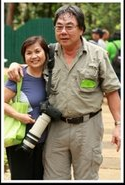Tuesday, December 12, 2006
Learning to spell and do math
Learning to Spell
When you are having fun, learning becomes easy. When Kathy was in first grade and learning to spell, she had a hard time. It was a frustrating experience for her. To help her out, we taught her a fun trick – which was to imagine each letter as a person. An “O” would be a rotund person, letter “I” would be a thin person, letter “T” has his feet together but arms outstretched at shoulder-height, letter “A” is standing with legs apart, letter “X” has his feet far apart and his arms outstretched above his head, etc.
As she spelled each word, she imagined the letters marching out one by one joining the others in the right sequence. We started her with short words, but pretty soon, she was spelling long words. Sometimes, she would laugh, imagining how awkwardly certain letters would walk to their position in the word.
Just recently, my husband was trying to write something but couldn’t get right the spelling of a certain word. He kept asking Kathy to repeat the spelling. Getting tired of doing so, Kathy, who is now 26, said, “papa, just imagine people as letters and they are marching one by one. Now, what do you see in your head? Who comes after E?”
Learning Math
Whether doing additions or subtractions, mental arithmetic is not much fun for a 5 year old. When Ching was in prep, she had math homework to do, but she was not in the mood to do them. I asked her to bring out her math worksheets, and we struggled with the first one. She was not paying any attention at all to what we were doing, and counting on our fingers did not do the trick, since our fingers, hers and mine together, only reached up to 20. (I wish I had heard of “Finger Math” then). I was really challenged to make math fun for her to do. I looked around the house for things that she could count, but there were hardly any that reached 21 to 99, until I happened to glance at a jar full of coins (to save money, I throw all my coins into the jar at the end of each day). I gave her some coins in different denomination, and we pretended to be buying and giving change to each other. Sometimes, when she did not have the exact change, she learned to combine different coins to reach the required amount. It was fun, and it took us only a few minutes to finish several pages of homework.
To add variety to things for us to count, I bought multi-colored popsicle sticks and beads, and we often laid them out on the entire floor of the children's room so we could see how much space a thousand sticks occupied when grouped in 5’s, 10’s, or 100’s. I think it helped in understanding math that we were touching them as we were counting. Math was real and physical, not just abstract and mental.
Kathy, on the other hand, learned math the easy way because her school had interdisciplinary programs – meaning, they did activities such as going to the zoo, cooking or doing stage productions, and through these activities, they learned math, writing and other subjects. At the zoo, for example, they helped in preparing food for the animals – and they learned fractions – mix 1-½ cups of chopped carrots with ¾ cup of sliced beans. For theater production, they learned the height, width and depth of props to take onstage, or length and width of costumes to sew.
One of the best-loved books in our family library is Mathemagic, part of a series of books called Childcraft. One of Ching’s early questions as a child was “Is there a number smaller than zero?” I told her yes, but I was befuddled as to how to explain the concept of negative numbers until I read Mathemagic. In one chapter, the book explained negative numbers in a way that a child could understand, by instructing the child:
a. Draw a line and step on it – that’s zero.
b. Take a step forward, that’s one.
c. Take another step forward, that’s two
d. Now, return to zero.
e. Take one step back, that’s minus one.
f. Take another step back, that’s minus two.
When third and final daughter Sacha came along, it was easy. We still had the coins, beads and popsicle sticks. She was playing and counting them even before she went to school. We had Mathemagic, and that was one of the first books she herself read.
Math is easy when it is fun.
Saturday, February 10, 2007
Subscribe to:
Post Comments (Atom)

No comments:
Post a Comment